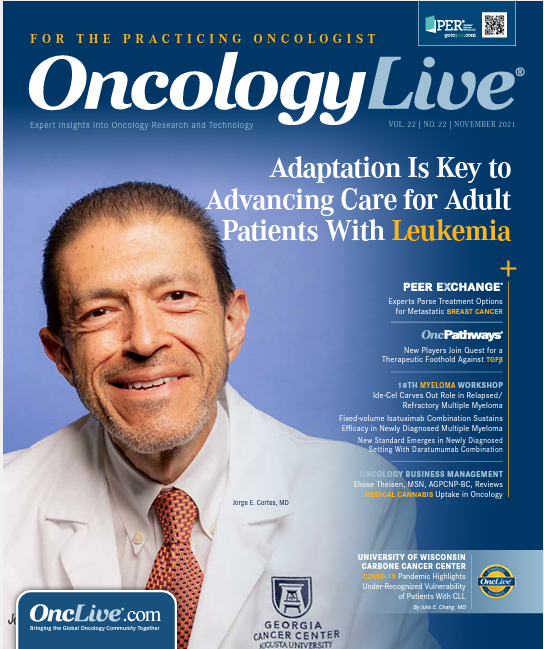Publication
Article
Brexucabtagene Autoleucel Expands Treatment Possibilities in ALL
Author(s):
Bijal Shah, MD, MS, discussed the results of the ZUMA-3 trial and how this approval will enhance the treatment of patients with relapsed or refractory B-cell precursor ALL.
Bijal Shah, MD, MS

Based on data from the phase 1/2 ZUMA-3 trial (NCT02614066), the FDA has approved the CD19-directed chimeric antigen receptor (CAR) T-cell immunotherapy brexucabtagene autoleucel (Tecartus) for the treatment of patients with relapsed or refractory B-cell precursor acute lymphoblastic leukemia (ALL).
In 54 evaluable patients, 51.9% (95% CI, 37.8%-65.7%) achieved complete remission (CR) within 3 months of infusion.1 The overall CR rate, comprising CR rate and CR with incomplete blood count (CRi) recovery rate, was 64.8% (95% CI, 51%-77%).1
In an interview with OncologyLive®, Bijal Shah, MD, MS, an associate member of the Department of Malignant Hematology at Moffitt Cancer Center in Tampa, Florida, discussed the results of the trial and how this approval will enhance the treatment of patients with relapsed or refractory B-cell precursor ALL.
Please describe the trial design of ZUMA-3.
This was a study of CAR-T cell immunotherapy for patients who had failed 2 lines of therapy or whose disease was primary refractory. We left the definition of what [qualifies as] primary refractory up to the investigator, [but participants] could include individuals who had no response to frontline therapy or individuals who were relapsing very quickly. Approximately one-third of patients [were] primary refractory and the rest [had disease relapse] after 2 or more lines of therapy.
The median number of prior lines [of therapy] was 2, with some patients having received up to 8. Approximately 40% of patients had [either] prior allogeneic stem cell transplant or [treatment with] blinatumomab [Blincyto]. By and large, these are heavily pretreated patients. They had to have morphologic disease [in bone marrow] and had to have at least 5% [bone marrow] blasts. The median [rate] of bone marrow blast was approximately 60% for those enrolled. [These patients had] fairly hefty tumor burden.
What were some of the key findings from ZUMA-3?
We observed a little [more than] 70% in terms of the CR/CRi rate. It’s really exciting. The majority of these remissions were true CRs, approximately 56%. For those who achieved a CR/CRi, the median duration of response was a little [more than] 12 months. With approximately 60 months of follow-up, a little [more than] 30% of patients were still experiencing an ongoing CR. We feel [these are] pretty powerful data and are excited that the FDA agrees.
[Further, the] median overall survival was 18.2 months.2 In this population of [patients with] primary refractory disease, multiple relapsed disease, or heavily pretreated disease, this is unheard of. We have not achieved this magnitude of overall survival in any of our previous trials. This is very exciting to me. It means we’re finally able to bring a therapy with tremendous potential to mediate an antitumor response, as we’ve seen in large B-cell lymphoma and mantle cell lymphoma, into ALL.
What adverse events should clinicians be aware of when prescribing brexucabtagene autoleucel?
When we talk about risks [with brexucabtagene autoleucel], we talk about them largely in the context of what we expect when we overactivate the immune system. These include CRS [cytokine release syndrome], fever, hypertension, and in some cases organ injury. With intervention with tocilizumab [Actemra] and/or steroids, we were able to push the rate of CRS down to approximately 25% [incidence] in terms of severe [adverse] events. I’m very happy with where we’ve landed, but certainly there’s room to do better.
The same goes for neurologic toxicities. This is where we’ve made our biggest dent, perhaps more than with CRS. It’s hard to know [exactly], but we were able to reduce the rate to approximately 25% for severe neurotoxicity. [In results of other studies of CAR T-cell therapy] in adults with ALL, the rate of severe neurotoxicity is in the 40% range. We did have 1 death from neurotoxicity, [which was] a case of brain edema with herniation.
It’s important to stress that there can still be rare events that culminate in bad outcomes. We also saw evidence of sepsis and infection as you might otherwise see in someone who is receiving therapy. When we look at all these events, what we’re seeing in terms of CAR T-cell therapy and the toxicity observed, [is that it is] still low relative to what we might see with other agents.
What does the future hold for brexucabtagene autoleucel?
One of the things we might try to do as we move forward is figure out how to implement this therapy in earlier lines and [for patients] with lower disease burden. [If] we can [treat patients] when they are less sick we can worry less about an infection. [Additionally,] with that lower disease burden we’re going to get better CAR T-cell expansion. We saw that in [ZUMA-3]—those with down to 5% blast had lower toxicity. That’s the perfect formula of low toxicity and high efficacy that we want for this therapy.
We must be open to exploring these options. When I talk about the future, it’s not 5 years from now, it’s now. We have these incredible therapies that are at our disposal. I’m looking forward to seeing how this plays out and excited that we get to add this new therapy to our treatment paradigm.
In light of this approval, is there anything you would emphasize to treating clinicians referring patients for therapy?
It’s always the same advice: refer early. There are things that we do in the academic setting—whether it’s molecular MRD [minimal residual disease] testing or more comprehensive genetic testing of the leukemia—to try to predict what’s coming [for patients] or to try to understand how to optimize novel agents, and now CAR T-cell therapy as part of that treatment paradigm. Referring early is the secret to having access to all these approaches for our patients. It really opens the door. We have an ability to better adapt to how unpredictable this disease can be. That’s what my colleagues [and I] want to be able to do, to help assist in the care of these patients.
References
- Tecartus. Prescribing information. Kite Pharma Inc; 2021. Accessed October 13, 2021. bit.ly/3o0RzFA
- Shah BD, Ghobadi A, Oluwole OO, et al. Phase 2 results of the ZUMA-3 study evaluating KTE-X19, an anti-CD19 chimeric antigen receptor (CAR) T-cell therapy, in adult patients (pts) with relapsed/refractory B-cell acute lymphoblastic leukemia (R/R B-ALL). J Clin Oncol. 2021;39(15):7002. doi:10.1200/ JCO.2021.39.15_suppl.7002









